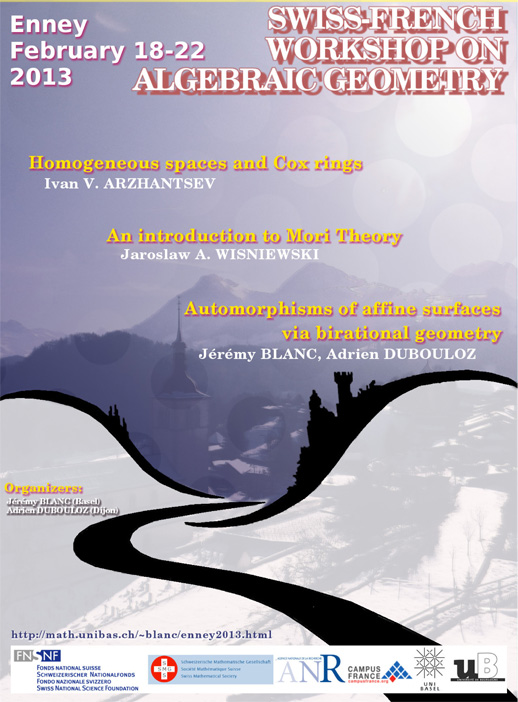|
2nd Swiss-French workshop on algebraic geometry
The workshop was held in Enney from February 18 to 22, 2013.
 Mini-courses
In the morning, there were three mini-courses of 5 hours (3 times one hour each day).
In the afternoon, we had research talks of 50 minutes. Schedule Talks: In Enney, ("Centre l'Ondine, Viva-Gruyère" )
Mini-courses - titles and abstracts
Talks - titles and abstracts
How to come The journey to Enney is 2 hours from Geneva, 2h30 from Basel/Zurich, 1h30 from Lausanne.See timetables on www.cff.ch. The train station of Enney is at 10 minutes by foot from the center. See the map, with the blue path given by google (pay attention to the snow!) Participants
Hamid Ahmadinhezhad (Linz)Rafael Andrist (Wuppertal) Bachar Al Hajjar (Dijon) Ivan Arzhantsev (Moscow) Ivan Bazhov (Moscow / Geneva) Cinzia Bisi (Ferrara) Jérémy Blanc (Basel) Gavin Brown (Loughborough) Alberto Calabri (Ferrara) Jung Kyu Canci (Basel) Fabrizio Donzelli (Ottawa) Adrien Dubouloz (Dijon) Jean-Philippe Furter (La Rochelle) Polina Kotenkova (Moscow) Isac Héden (Uppsala) Seyed Reza Hosseini (Jena) Anne-Sophie Kaloghiros (London) Kevin Langlois (Grenoble) Matthias Leuenberger (Bern) Lucy Moser-Jauslin (Dijon) Stefan Maubach (Bremen) Karol Palka (Warsaw) Alexander Perepechko (Grenoble/ Moscow) Charlie Petitjean (Dijon) Marta Pieropan (Munich) Pierre-Marie Poloni (Basel) Maria Fernanda Robayo (Basel) Elena Romaskevich (Moscow) Łukasz Sienkiewicz (Warsaw) Immanuel Stampfli (Basel) Ronan Terpereau (Grenoble) Christian Urech (Basel) Jaroslaw A. Wisniewski (Warsaw) Susanna Zimmermann (Basel) Organisers
Adrien Dubouloz (Dijon)Jérémy Blanc (Basel) Financial support
We gratefully acknowledge support from:Swiss mathematical society Swiss doctoral program French ANR, project BIRPOL University of Basel | |||||||||||||||||||||||||||||||||||||||||||||||||||||||||||||||||||
